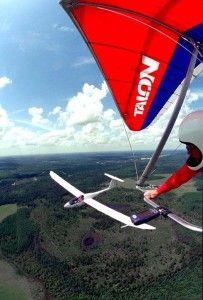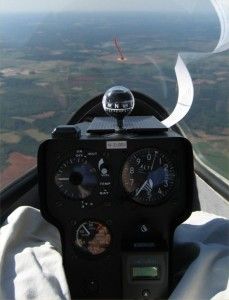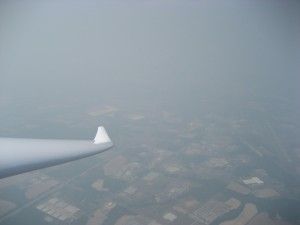For several years I’ve had the opportunity of visiting Wallaby Ranch in Florida during the week of the EAA’s annual Sun ‘n Fun fly-in. The Spring-time weather has typically been excellent and I have enjoyed sharing the sky with Steve Arndt in his Magic Dragon and other ranch pilots flying various light gliders and hang gliders. A personal desire has been for good weather on the last day of these April trips so that it would be possible to fly northbound up the spine of Florida, taking advantage of the peninsula’s “convergence ridge” and a favorable tailwind. This has a ground-crew logistics benefit too – we all head home after Sun ‘n Fun tracing the same route up Interstate 75 through Georgia, thus avoiding a dedicated out-and-return drive normally needed for a straight distance flight. Perfect conditions would allow for a run to the home field in Tullahoma, Tennessee – just hair over 900km from Wallaby – or even more optimistically, to Gallatin, Tennessee – which would amount to 1000km (a distance challenge worth considering – especially with a sailplane with low wing loading).
This season we had brought the FAI – DU class glider (less than 220kg take-off weight) non-motorized Silent 2 to Wallaby and had some memorable area flights, all the while checking the forecasts for the last day or two of the trip to take advantage of a southerly wind. The unpowered carbon/glass Silent 2 weighs only 128kg (283 lbs) empty and, with a wing area of 8.8 m2 (95 ft2), has a wing loading of 25 kg/m2 (5.1 lbs/ft2) at the FAI 220 kg value. For comparison, Steve’s wood/carbon/fabric Magic Dragon is a featherweight 81kg (180 lbs) empty and, with its relatively high wing area of 14.5 m2 (156 ft2), has a wing loading of only 11.6 kg/m2 (2.37 lbs/ft2); about as light as it gets.
It turned out the weather on the last day was decent for a distance attempt, but insufficient to shoot for a mega flight all the way home to Tennessee. The lift forecast was good, and with the predicted easterly wind off by 90 degrees throughout Florida (instead of aligned with the spine), a 500km declared distance to goal was the logical choice. Steve Arndt had already targeted a place called Montezuma in Georgia for his 500km in the Dragon and, per his suggestion, it made sense to use this small-town airport near Macon as the goal. After considering the strong wind forecast, Steve prudently elected to wait for another day to try for 500km in his Magic Dragon.
The morning of the flight, visiting friend and LS-8 driver, Peter Pförtner, helped ready the Silent 2 and we were able to launch shortly before the 10:00am breakfast bell (Malcolm Jones of Wallaby has a classic New England school bell suspended in a wooden trestle tower near the dining area) into some wild air only to have the nose-hook side release at 1200 feet due to some turbulence. The lift was too choppy to climb out and in hindsight I should have landed immediately instead of consuming precious minutes trying to make a save. Malcolm was gracious to provide a second tow even though the operations had paused for the morning meal. By the time of the second launch, the sky was beginning to be dotted with small cloud puffs and once into the organized lift it was easy to tank up to cloudbase in the start sector then head off on course. Daniel Schur and John Dotson, Tullahoma friends and Sun ‘n Fun volunteers, left Wallaby shortly after, headed northbound with the empty trailer in tow.
Right from the start, the lift was predictable and consistent with the challenge being the 15kt crosswind from the east and choppy thermals. The numerous ponds and lakes below showed smooth water at their upwind edges, clearly indicating the surface-wind direction. I diligently stayed to the west of Highway 27 which delineates the edge of the Orlando airspace. The flight path went right past the landmark Mickey Mouse tree circles (three circular stands of trees arranged in a pattern of the famous rodent’s silhouette) located amongst the orange groves on the opposite side of the north-south highway.
By Leesburg the flight had settled into a steady groove, with a westward drift from course in each thermal followed by an upwind correction during each glide, when a peripheral movement in the corner of my right eye suddenly drew my attention. I panned my head and looked slightly downward in line with the leading edge of the right wing to view a high-wing Cessna single on a collision course and a split-second image of its pilot looking at a chart in his lap! My incredulous eyes instinctively closed in anticipation of the Cessna’s vertical stabilizer slicing the tail-boom off the glider, but instead the momentary drone of the Cessna’s engine resonated through the glider’s airframe. My head quickly pivoted one-eighty degrees while letting out an expletive and, looking back over my left shoulder, there was the Cessna still on the same course but now at a higher altitude than the glider. Whew! The word “near” in near-miss just does not quite do this one justice. The soaring community almost had an unneeded aviation statistic that day. The event lasted perhaps two seconds and there was nothing to do other than acknowledge it was not my time, clear my head, and get back to flying the rest of the task. Personal interest in some of the collision warning devices (Flarm) has understandably grown stronger.
The flight became a bit more challenging about halfway between Ocala and Gainesville with some swampy terrain that presented weaker lift and fewer land-out options. This resulted in a bit of a dogleg in the flight trace. After that, conditions really strengthened and by northern Florida the wind began to have a favorable quartering component.
I had been regularly checking the battery condition during the flight using the voltmeter switch on the Ilec vario, but now the percent value was dropping too fast each time I checked it! What?! Was the three-year old battery no longer capable of holding a full charge? Note that this glider was built purposefully light and only has one non-removable battery (fed by a solar-panel), a single vario, and a Colibri GPS logger – very simple yet sufficient. During both the previous afternoon check and morning pre-flight the battery display had shown 99% charge (the maximum value of the 2-digit display).
A few glides later, the Colibri began to beep obnoxiously and display a low battery warning each time the glider was in the shadow of a cloud. It would then come alive again, with the desired display of bearing & track, while cruising in the sunlight to the next thermal. I questioned if it was still logging while the low battery warning was on and whether this flight recording file would be valid. I assumed it was still recording and decided to make every effort to keep the logger alive, resorting to only turning the vario on to center thermals and turning it off during climb and cruise. The high sun was now off the left wing so I pulled the laminated white checklist card out of the cockpit side pocket and curved it between the edge of solar panel mounted on top of the instrument pod and the canopy immediately above the pod as an improvised reflector. Once it was in place, I laughed quietly at the thought of this being merely a desperate measure, but it actually made a slight difference in the percentage reading. The objective now was on keeping the Colibri ticking to the 500km goal in mid-Georgia and recording a valid flight.
The brilliant Florida air quality came to an abrupt end in southern Georgia near Valdosta. Ahead I could see a light-brown-colored ominous looking wall stretching from ground level to the inversion layer. It was a thick band of heavy smoke originating from the Okefenokee swamp fires many miles to the east and I fully expected this to shut down the lift. Surprisingly the grayed conditions still had excellent lift with clouds up to 7000 feet! I stayed right over I-75 to help navigate (the Colibri was no longer helping; its usual display of track and bearing long since replaced by the persistent “Battery Low!” warning) and had to look upwards to spot any clouds. The visibility straight ahead was without a discernable horizon. Thermaling in the foul acrid air was downright sickening and to my surprise some nausea came on so suddenly and strongly that I thought seriously which would be the less messy option: the canopy’s side window or my hat. Fortunately it passed after a brief cold sweat. What kind of noxious stuff was in that smoke!?
Beyond Tifton the air became clear again with unlimited visibility. The regular clouds of Florida were long gone, replaced by the blue skies of the high pressure system to the east and a favorable tailwind. The rest of the flight proceeded smoothly even without use of the variometer. The lift along I-75 was excellent and within short order Cordele passed below after which the interstate and flight course diverged, requiring more detailed glances at the sectional chart. I estimated there were still at least two more hours of useable lift, but with the blue conditions, depleted battery, and 6.5 hours in the saddle it made sense to call it a day and final glide into Montezuma instead of pushing on for a free-distance Florida state record.
Fortunately the Colibri did log a valid flight trace (my only suggestion to the software developers is that the battery warning repeat momentarily instead of permanently replacing the navigation information). The first indication of the logger working was the sweet sounding beep as the glider entered the finish sector at Montezuma. After a few “celebratory maneuvers” to lose altitude and an uneventful landing, I was greeted by a friendly dog at the otherwise deserted airport, followed by a few quick calls to Wallaby Ranch to let Steve, Malcolm, and Peter know that the flight was a success.
While waiting for the chase crew I stretched stiff legs, snacked, and checked the glider over to see what kind of bug count was on the wings. To my surprise there were negligible bugs, but the wing leading edges had a fairly thick and tacky powder-like brown coating on them, no doubt from all the smoke. Daniel and John arrived within minutes and confirmed that the interstate had all kinds of poor visibility road-side warning signs and travel delays. We snapped a few photos, loaded up the glider, and headed on to Tennessee with the two of them providing a much entertaining version of the front row caricature commentary from Mystery Science Theatre. Actually, a road trip with Daniel and John is a “you’ll be laughing in stitches” experience that would make a good story in its own right.
So what was the reason for the glider’s low battery condition? It is pretty obvious now and it falls well within the “you should have known better” category. When I checked the battery the afternoon of the previous day and prior to launching, the sailplane was in the sunshine and the voltmeter was of course displaying the combined battery and solar system voltage, not the battery voltage alone (the solar panel and battery share a common circuit and, in this particular glider’s installation, cannot be switched independently). With a solar charging system that would allow for many days of flying without the battery needing a charger top up, I just never gave it much additional thought. The solution is a simple one: when in the sun, cover the solar panel prior to checking the initial battery condition. So, there is a lesson to be learned with every flight.
The stats for the flight result in a distance of 502.5 km (271.3 nm), average speed of 77.5 km/h (41.8 kts), average lift of 1.8 m/sec (3.5 kts), 49 thermals, a total altitude gain of 15,630 m (51,280 feet), 10.1 km (5.5 nm) average glide, and a mean L/D of 32:1 in a 39:1 max L/D glider. All told, a fine way to conclude a four-day trip to the sunshine state.
A little over a year later I was super pleased to receive a call from Steve Arndt. He had just landed at Montezuma in his Magic Dragon! Look for a side-by-side comparison of the two flights in a future article.













4 comments for “Florida 500km Goal Flight in a Light Sailplane”